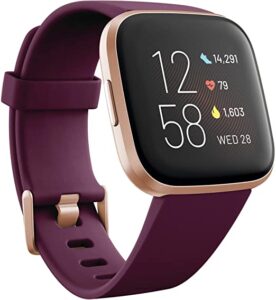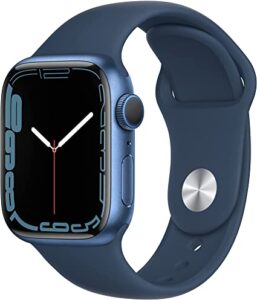Last Updated on November 29, 2022 by Luis Cooper
Can Smart Watches Measure Blood Pressure?
Your blood pressure is a critical biometric that tells you a lot about what’s going on within your body.
Even if you don’t have hypertension or a family history, monitoring your blood pressure value is crucial, especially as you get older or if you’re pregnant.
Untreated high blood pressure can cause various health problems, from optic nerve damage to heart disease.
You and your doctor can determine whether you need to adjust your medications, diet, exercise, or other activities once you know your blood pressure.
It’s essential to take readings frequently because blood pressure can fluctuate throughout the day.
However, most people used to have to rely on a doctor’s office to acquire an accurate blood pressure reading.
Consumer-friendly blood pressure cuffs are handier because these cuffs can be used at home, but they are large and uncomfortable, so you may not be able to wear them all the time.
Blood pressure monitor watches and fitness trackers allow you to take measurements whenever you choose, even on the road.
Some of these gadgets may even track your steps and sleep patterns.
Wrist blood pressure monitors that don’t look like watches are also available.
These gadgets are more significant and primarily intended for usage at home.
We are experiencing a daily reality such that everything is moving at breakneck speed.
New technologies are developed daily, and new opportunities for humanity to benefit are discovered.
When it comes to the watch sector, significant improvement and progress are also evident.
It can be observed in the features the smartwatch provides its users.
One of the most valuable functions that the watch business provides its customers is the ability to measure their blood pressure.
Can Smart Watches Measure Blood Pressure?
So let’s take a closer look at the smartwatch’s blood pressure monitoring capabilities.
Heart Monitor Sensors?
Many smartwatches come equipped with the necessary sensors for health monitoring out of the box.
The sensors are located on the watch face’s underside and always rest against your wrist’s skin.
Most watches follow instructions on setting the look on your wrist to get the most accurate data.
The sensors produce light that passes through the skin, allowing your watch to monitor blood flow.
The sensor can then determine the rate at which your heart beats.
Advanced features, like ECG capabilities, are available on some smartwatches.
The sensors for this aren’t hidden beneath the face of the watch. Instead, they are reachable and can be touched with a finger.
The gadget monitors electrical signals when a finger is placed on the sensor.
It determines whether your heart’s heart rate rhythms are irregular or regular.
How does a smartwatch work to measure blood pressure:
How can smart watches measure blood Pressure?
Smartwatches utilize the principle of hemodynamics to measure blood pressure.
Pulse transit rate is something through which a smartwatch measures blood pressure.
What is the pulse transit time?
It is the calculation of the time interval between the squeezing of the heart and the wrist getting more and more blood flow from the heart.
An optical sensor is built into smartwatches.
It can detect and measure the difference between oxygenated and deoxygenated blood and pulsatility.
Typically, an EKG is required to detect when the heart contracts, and a device is needed to measure the pulse.
This EKG is absent in smartwatches.
In smartwatches, blood pressure is calculated by looking at the features of the pulse curve.
For example, it detects the slope and whether the curve moves toward the right or left.
The data on the graph and the user’s age, height, and gender are combined to measure the individual’s blood pressure.
How accurately do smartwatches measure blood pressure?
One should not rely entirely on the smartwatch for measuring blood pressure, especially if one blood pressure keeps on increasing or decreasing.
It is because the results provided by smartwatches are not so accurate.
After all, smartwatches are uncalibrated.
Smartwatches are not clinically verified to be used as an instrument for detecting blood pressure.
However, famous intelligent watches have now arrived in the market like Apple and Garmin that measure blood pressure so accurately and also provide the user the feature of measurement of ECG.
That is a plus point and a remarkable achievement in the progress of the watch industry.
American Health Association suggests that the most precise and accurate reading of blood pressure is the one that is measured by the upper arm cuffs.
It is a significant positive point for obese persons who can use or find it difficult to measure their blood pressure through the upper cuff arms.
Why Using a Wearable Device to Measure Your Blood Pressure Isn’t a Good Idea:
Home monitors can help you keep track of your blood pressure and keep it under control if you have high blood pressure.
Most existing devices are stand-alone with cuffs that you put on your wrist or upper arm, similar to what your healthcare practitioner uses.
On the other hand, smartwatches and fitness trackers are starting to join in the fun.
Wearable devices or smartphone apps—which many people use to track heart rate, sleep patterns, and more—could make tracking your blood pressure simpler and more convenient.
Fitness trackers, smartwatches, and applications that purport to measure blood pressure have yet to be tested by Consumer Reports.
We did, however, conduct a study of the medical literature and consult with several independent experts.
They informed us that while the devices’ technology is promising, they are still developing and may not match the accuracy of a more typical home monitor, particularly one with an upper arm cuff.
The American Heart Association (AHA) recommends it.
Because of their design and placement on the arm, the accuracy of blood pressure readings from smartwatches is limited.
Recent studies have shown that differences of up to 10% and even more can exist between manual measurements taken by nurses and instantaneous readings obtained with a touchscreen device like an Apple Watch.
It puts them at a higher risk of inaccuracy when making lifestyle interventions for chronic conditions requiring significant attention to low-level symptoms.
When there is a suspicion of symptoms or a diagnosis that requires accurate monitoring or management, these devices should be used as an additional tool to examine trends in data over time rather than as a replacement for seeing a healthcare provider.
Which smartwatch to choose?
Although this hasn’t been shown in large-scale investigations, blood pressure monitor watches may provide reliable readings.
When it comes to taking your blood pressure, you don’t have a choice.
The Omron HeartGuide is the only watch on the market that can measure blood pressure and has been approved by the FDA.
When it comes to heart rate monitors, though, there are a variety of solutions to choose from.
The obvious choice is Apple.
Their watches have various heart-monitoring features, such as heart rate and ECGs.
However, except for changing watch straps, there isn’t much variety.
Knowing what type of analysis you want when looking for a smartwatch with your heart is helpful.
Garmin or Fitbit will undoubtedly have the edge if you enjoy sports or working out and want your watch to help you be more effective because fitness is their specialty.
If you want to improve your overall health, Apple has several health apps that include heart tracking.
Garmin and Fitbit both provide a variety of timepieces to suit different tastes.
Many of these watches include a heart rate sensor built in.
There’s no need to look at the Garmin watches if you want to perform an ECG, and Fitbit won’t provide you with the regard you want if you want the flexibility to download a wide selection of apps.
Conclusion:
Although this hasn’t been shown in large-scale investigations, blood pressure monitor watches may provide reliable readings.
It may be preferable to use a watch developed expressly for this purpose rather than a fitness tracker that contains this feature to receive the most accurate and consistent results.
People who want to check their blood pressure multiple times a day may benefit from wearing a blood pressure monitor watch.
People who want to check their blood pressure and heart rate before and after exercising may find fitness trackers with this helpful feature.
If you have a health issue like hypertension, don’t rely solely on wrist monitors for your measurements.
There is no substitute for a healthcare professional’s monitoring.
If you have any questions, please ask in the comments below.
Related posts:
Best Smartwatches with Blood Sugar Monitor



